Figure 1.
(a) Cancer stem cells (CSCs) definition. The cancer cell compartment of a tumour is constituted by a heterogenetic hierarchically organized mass of tumour cells. CSCs are the most tumorigenic pool of cells among the hierarchy defined using experimental assays. The size of the identified pool directly correlates with the challenge of the test applied; so, the higher the challenge, the smaller the amount of cells able to succeed. In vivo CSCs are defined for their ability to recapitulate the original tumour structure when transplanted in recipient mice. (b) The CSC hallmarks. (i) The first hallmark is the ability to induce microenvironmental changes in order to create their favourable environment, allowing the expression of their characteristic CSC capability. (ii) The ability to self-renew: to propagate while maintaining their CSC characteristics, as well as generating the other less potent cancer cells that constitute the original tumour cell mass. These first two abilities are linked to the in vivo tumour-initiation capacity of CSCs. (iii) The ability to maintain the tumour mass homoeostasis while the tumour grows and progresses. (iv) The intrinsic ability to survive chemotherapy or radiotherapy, and therefore the potential to generate relapses starting a new process of self-renewal and growth (iv–ii). From a certain moment of tumour progression, cells will start to disseminate within the organism and a new cycle of tumour initiation will require the same hallmarks at the distant site to enable metastatic outgrowth (iii–i).

